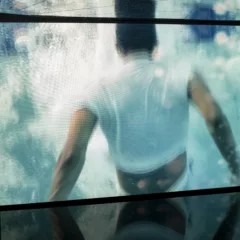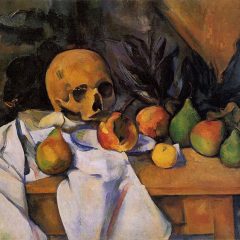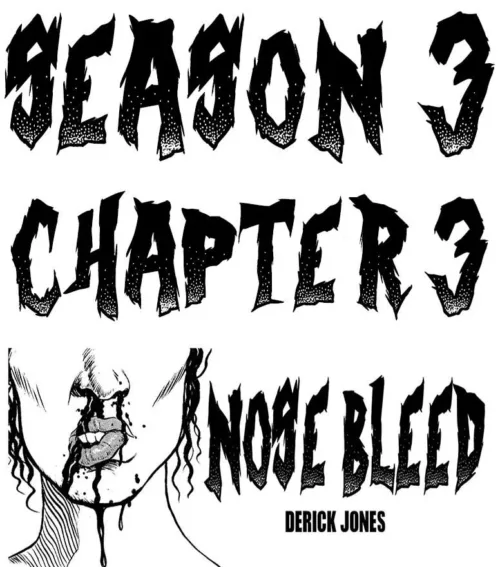 The exuberant Shovel Show at Highwire Gallery is a welcome jumble of art related to shovels, curated by Highwire guy Jeff Thomas.
The exuberant Shovel Show at Highwire Gallery is a welcome jumble of art related to shovels, curated by Highwire guy Jeff Thomas.
Sculpture rules
Sculpture dominated, not so surprising for a show about a ubiquitous tool. Four large sculptures of shovels dominated the big space, starting with Jeff Thomas‘ man-of-the-earth “Fantasy Shovels” (top). Their wiggly tree-branch handles (and sometimes work ends), sometimes hung with chains and other bulky hardware, went in all kinds of untamed directions.

Brian Wagner‘s yellow version of his sticks-meet-gravity sculpture, stretches the shovel idea to tools with long handles. Suddenly, pushing the dirt with a mop or a broom seems not that different from shoveling.
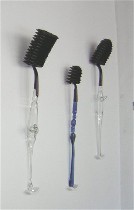
The merger of glass and steel in Larry Livolsi‘s “Missile Tip Rumba” series looked tempting to touch, the glass shafts as individual and relaxed as the metal shovel tips were prickly and industrial.
The anti-plastic
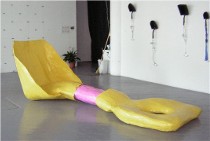
The antithesis of industrial was Stephanie Lincoln‘s cheerful, simple beach toy, a giant sand shovel made in paper mache, the anti-plastic. While not profound, it had a joyousness that gave it ur-sand-shovel status. (And it was parked outside Highwire’s new video screening room, showing “Shovel Joy” by Jennifer Brinton Robkin. I watched one of the three videos, a child playing in the sand for what seemed like forever, until I lost patience and didn’t see the others. The child’s patience was endless.)
Smaller sculptures
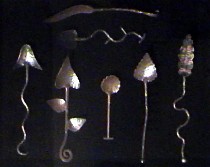 Those were the big four, but the room was also punctuated with lots of little shovels as well. Allen Ritzman‘s charming “Fairy Shovels” (shown) and John Massey‘s “Aberrant Evolution” were tableware scale. Massey’s work, the rougher of the two, showed a progression through spoons to a small pitchfork to a regular fork, etc.–all the perfect way to shovel down food. Although I’ve been known to call spatula’s shovels, and people seem to talk about shoveling down food, this little progression in implements brought the concept to another level and amused at the same time.
Those were the big four, but the room was also punctuated with lots of little shovels as well. Allen Ritzman‘s charming “Fairy Shovels” (shown) and John Massey‘s “Aberrant Evolution” were tableware scale. Massey’s work, the rougher of the two, showed a progression through spoons to a small pitchfork to a regular fork, etc.–all the perfect way to shovel down food. Although I’ve been known to call spatula’s shovels, and people seem to talk about shoveling down food, this little progression in implements brought the concept to another level and amused at the same time.
Sculpture meets 2-D
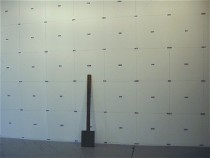 The flat, iconic shovel in the middle of Lydia Hunn‘s “Shit/Snow/Sand” was a nice fit with the word-punctuated grid of grueling shoveling chores. I appreciated how the chores were neatly boxed off, like my shoveling jobs never manage to be.
The flat, iconic shovel in the middle of Lydia Hunn‘s “Shit/Snow/Sand” was a nice fit with the word-punctuated grid of grueling shoveling chores. I appreciated how the chores were neatly boxed off, like my shoveling jobs never manage to be.
Also walking the 2-D/3-D line was  Floss Barber‘s “Karma,” a mix of painting and glass shovels from small to large, but my favorite bit of the installation was the Buddhas rowing with shovel oars in the striped-glass shovel boats, wifty enough to delight and mystify (detail shown).
Floss Barber‘s “Karma,” a mix of painting and glass shovels from small to large, but my favorite bit of the installation was the Buddhas rowing with shovel oars in the striped-glass shovel boats, wifty enough to delight and mystify (detail shown).
Paint and photos
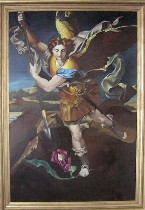 Talking of wifty, and moving into full-blown 2-D, Katie Bidlingmaier‘s “St. George and the Dragon” was pre-Raphaelite, buff, and just plain funny. I can just picture Wonder Woman in a similar pose. To paint like this at this point in time and take yourself seriously doesn’t work. But add a touch of arch and a soupcon of the ridiculous and it flies. I’m not sure why St. George is sporting a shovel, but I’m glad, because otherwise he wouldn’t have made it into this show.
Talking of wifty, and moving into full-blown 2-D, Katie Bidlingmaier‘s “St. George and the Dragon” was pre-Raphaelite, buff, and just plain funny. I can just picture Wonder Woman in a similar pose. To paint like this at this point in time and take yourself seriously doesn’t work. But add a touch of arch and a soupcon of the ridiculous and it flies. I’m not sure why St. George is sporting a shovel, but I’m glad, because otherwise he wouldn’t have made it into this show.
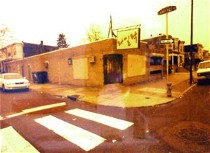 The other 2-D work that worked its way into my heart were a series of sepia-tone photographs by Mitru Costea mostly of shovels abandoned and forlorn, like stand-ins for people. Their sepia coloring, with a suspicious touch of yellow (to look contemporary?), seemed to go with the theme of things once used, now forgotten, now reconstituted.
The other 2-D work that worked its way into my heart were a series of sepia-tone photographs by Mitru Costea mostly of shovels abandoned and forlorn, like stand-ins for people. Their sepia coloring, with a suspicious touch of yellow (to look contemporary?), seemed to go with the theme of things once used, now forgotten, now reconstituted.
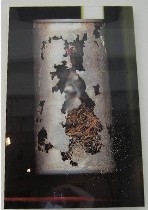 And speaking of photos, Midge Valdez’ ink jet photo (“untitled” shown)was also a sad affair, although with a bit of humor, the hay sticking out through the crack in the tin can. The image was full of little byways and passages for plenty of looking.
And speaking of photos, Midge Valdez’ ink jet photo (“untitled” shown)was also a sad affair, although with a bit of humor, the hay sticking out through the crack in the tin can. The image was full of little byways and passages for plenty of looking.
Space for rent
I’d like to mention a couple of the paintings in the smaller room, which is, by the way, a 640-square-foot space for rent, said Highwire’s Van Zandt, who also wanted to make sure I and you got the point that the gallery has a nice video screening space–so if you’re a video artist, consider it.
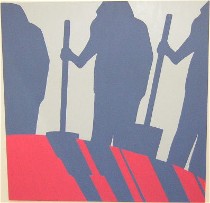 “Working Class Heroes” (shown) and “A Ditch Digger’s Work Gets Him Down” both by Bill Mayes, sort of walk the line between advertising (have we all seen too many iPod silhouettes?) and something to say, but they are fun to look at. I also liked the titles.
“Working Class Heroes” (shown) and “A Ditch Digger’s Work Gets Him Down” both by Bill Mayes, sort of walk the line between advertising (have we all seen too many iPod silhouettes?) and something to say, but they are fun to look at. I also liked the titles.
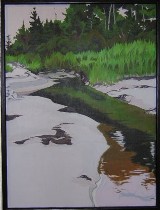 And Kathleen Wert‘s “Dirt Series” (shown, “Dirt Series: Sandstone”) in a familiar, hard-edge style got a little sexiness added in that lifted it above.
And Kathleen Wert‘s “Dirt Series” (shown, “Dirt Series: Sandstone”) in a familiar, hard-edge style got a little sexiness added in that lifted it above.
 And then, on the way out (or the way in), Abe Rothblatt‘s shovel on the hallway wall, painted like an adult pretending he’s a kid, and labeled “A Cross Between a Barnet Newman Painting and a Shovel” gave the show it’s farewell kick.
And then, on the way out (or the way in), Abe Rothblatt‘s shovel on the hallway wall, painted like an adult pretending he’s a kid, and labeled “A Cross Between a Barnet Newman Painting and a Shovel” gave the show it’s farewell kick.
Roberta said she like the whole Rothblatt installation in the hallway, and she might weigh in later on it.


